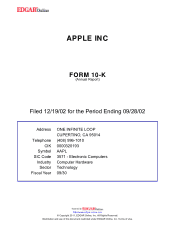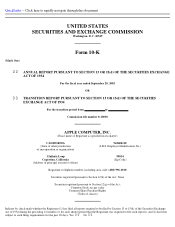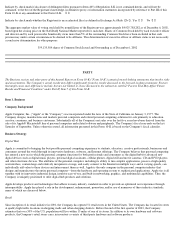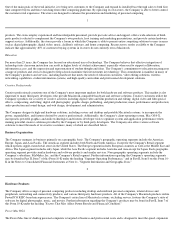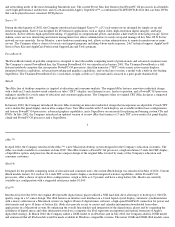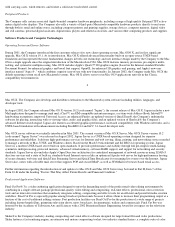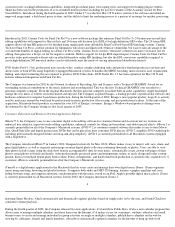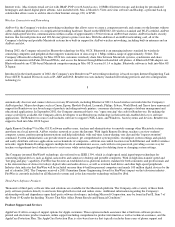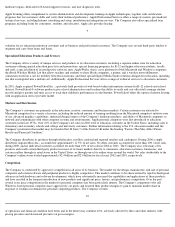Apple 2002 Annual Report Download - page 11
Download and view the complete annual report
Please find page 11 of the 2002 Apple annual report below. You can navigate through the pages in the report by either clicking on the pages listed below, or by using the keyword search tool below to find specific information within the annual report.
The principal competitive factors in the market for personal computers include relative price/performance, product quality and reliability,
design innovation, availability of software, product features, marketing and distribution capability, service and support, availability of hardware
peripherals, and corporate reputation. Further, as the personal computer industry and its customers place more reliance on the Internet, an
increasing number of Internet devices that are smaller, simpler, and less expensive than traditional personal computers may compete for market
share with the Company's existing products.
The Company is currently taking and will continue to take steps to respond to the competitive pressures being placed on its personal computer
sales as a result of innovations in the Windows platform. The Company's future operating results and financial condition are substantially
dependent on its ability to continue to develop improvements to the Macintosh platform in order to maintain perceived functional and design
advantages over competing platforms.
Further information relating to the competitive conditions of the personal computing industry and the Company's competitive position in that
market place may be found in Part II, Item 7 of this Form 10-K under the heading "Factors That May Affect Future Results and Financial
Condition."
Raw Materials
Although most components essential to the Company's business are generally available from multiple sources, certain key components
(including microprocessors and application-specific integrated circuits ("ASICs")) are currently obtained by the Company from single or
limited sources. Some other key components, while currently available to the Company from multiple sources, are at times subject to industry
wide availability constraints and pricing pressures. In addition, the Company uses some components that are not common to the rest of the
personal computer industry, and new products introduced by the Company often initially utilize custom components obtained from only one
source until the Company has evaluated whether there is a need for, and subsequently qualifies, additional suppliers. If the supply of a key or
single-sourced component to the Company were to be delayed or curtailed or in the event a key manufacturing vendor delays shipments of
completed products to the Company, the Company's ability to ship related products in desired quantities and in a timely manner could be
adversely affected. The Company's business and financial performance could also be adversely affected depending on the time required to
obtain sufficient quantities from the original source, or to identify and obtain sufficient quantities from an alternative source. Continued
availability of these components may be affected if producers were to decide to concentrate on the production of common components instead
of components customized to meet the Company's requirements. The Company attempts to mitigate these potential risks by working closely
with these and other key suppliers on product introduction plans, strategic inventories, coordinated product introductions, and internal and
external manufacturing schedules and levels. Consistent with industry practice, the Company acquires components through a combination of
formal purchase orders, supplier contracts, and open orders based on projected demand information. These formal and informal commitments
typically cover the Company's requirements for periods ranging from 30 to 130 days.
The Company believes there are several component suppliers and manufacturing vendors whose loss to the Company could have a material
adverse effect upon the Company's business and financial position. At this time, such vendors include Agere Systems, Inc., Ambit
Microsystems Corporation, ATI Technologies, Inc., Elite Computer Systems Co., Inc., Hon Hai Precision Industry Co., Ltd., IBM Corporation,
Inventec Appliances Corporation, LG. Phillips Co., Ltd., Matsushita, Mitsubishi Electric Corporation, Motorola, Inc., Nvidia Corp., Quanta
Computer, Inc., Samsung Electronics, Solectron Corporation, and Toshiba Corporation.
11
Further discussion relating to availability and supply of components and product may be found in Part II, Item 7 of this Form 10-K under the
heading "Factors That May Affect Future Results and Financial Condition," and in Part II, Item 8 of this Form 10-K in the Notes to
Consolidated Financial Statements at Note 10 under the subheading "Concentrations in the Available Sources of Supply of Materials and
Product."
Research and Development
Because the personal computer industry is characterized by rapid technological advances, the Company's ability to compete successfully is
heavily dependent upon its ability to ensure a continuing and timely flow of competitive products and technology to the marketplace. The
Company continues to develop new products and technologies and to enhance existing products in the areas of hardware and peripherals,
system software, applications software, networking and communications software and solutions, and the Internet. The Company's research and
development expenditures, before any charges for purchased in-process research and development, totaled $446 million, $430 million, and
$380 million in 2002, 2001, and 2000, respectively.
Patents, Trademarks, Copyrights and Licenses
The Company currently holds rights to patents and copyrights relating to certain aspects of its computer systems, peripheral systems, and
software. In addition, the Company has registered, and/or has applied to register, trademarks and service marks in the United States and a
number of foreign countries for "Apple," the Apple silhouette logo, the Apple color logo, "Macintosh," and numerous other product trademarks
and service marks. In 1986, the Company acquired ownership of the trademark "Macintosh" for use in connection with computer products.

